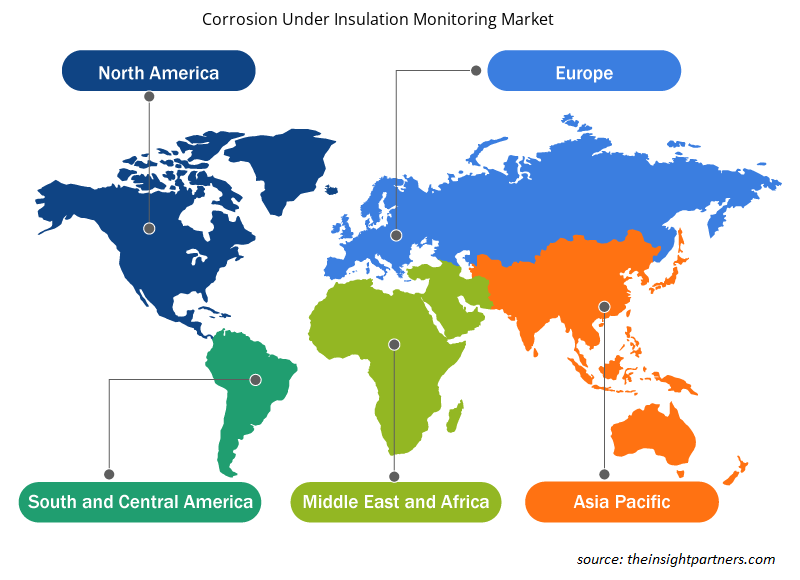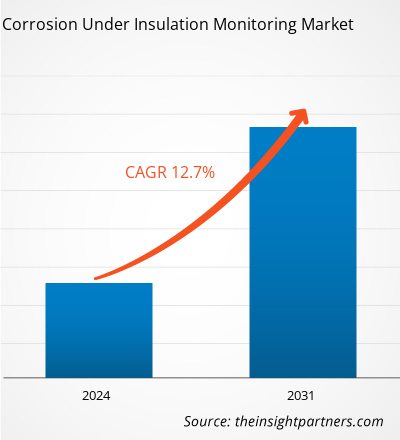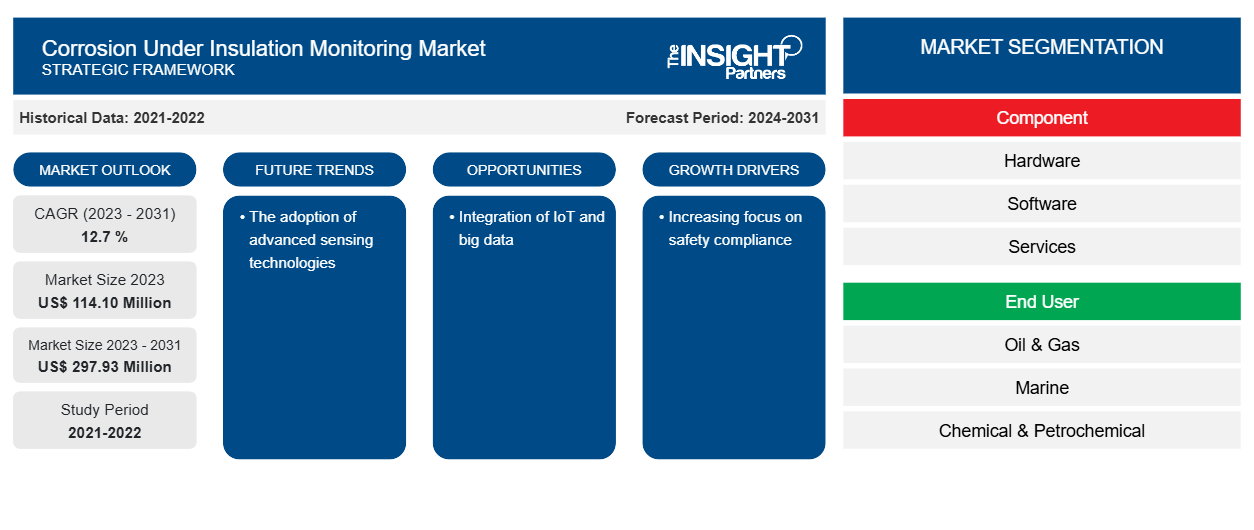Der Markt für Korrosionsüberwachung unter Isolierung soll von 114,10 Millionen US-Dollar im Jahr 2023 auf 297,93 Millionen US-Dollar im Jahr 2031 anwachsen. Der Markt wird zwischen 2023 und 2031 voraussichtlich eine durchschnittliche jährliche Wachstumsrate (CAGR) von 12,7 % verzeichnen. Die Einführung fortschrittlicher Sensortechnologien dürfte ein wichtiger Trend auf dem Markt bleiben.
Marktanalyse zur Überwachung von Korrosion unter Isolierung
Der zunehmende Fokus auf die Einhaltung von Sicherheitsvorschriften, staatliche Initiativen in Bezug auf korrosionsbezogene Vorschriften und zunehmend fortschrittliche Technologien treiben den globalen Markt für Korrosionsüberwachung unter Isolierung hauptsächlich an. Darüber hinaus treibt die zunehmende Zahl von Start-up-Unternehmen die Expansion des Marktes für Korrosionsüberwachung unter Isolierung weltweit voran. Korrosion unter Isolierung (CUI) ist eine der heimtückischsten Korrosionsarten. Daher wird sie in den Inspektionsrichtlinien als einer der wichtigsten externen Korrosionsmechanismen in Anlagen angesehen, die besondere Sorgfalt erfordern.
Marktübersicht zur Überwachung von Korrosion unter Isolierung
Korrosion unter Isolierung (CUI) gilt als großes Korrosionsproblem, das der Öl- und Gasindustrie, der chemischen und petrochemischen Industrie sowie der Lebensmittelverarbeitung jährlich Millionen von Dollar an Inspektions-, Reparatur- und Austauschkosten kostet. CUI kann die Integrität einer isolierten Pipeline oder eines isolierten Behälters beeinträchtigen, wenn sie nicht frühzeitig erkannt wird, und Lecks verursachen, die zu möglichen Katastrophen führen können. Korrosion unter Isolierung (CUI) ist eine der heimtückischsten Korrosionsarten. Daher wird sie in den Inspektionsrichtlinien als einer der wichtigsten externen Korrosionsmechanismen in Anlagen angesehen, die besondere Sorgfalt erfordern.
Passen Sie diesen Bericht Ihren Anforderungen an
Sie erhalten kostenlose Anpassungen an jedem Bericht, einschließlich Teilen dieses Berichts oder einer Analyse auf Länderebene, eines Excel-Datenpakets sowie tolle Angebote und Rabatte für Start-ups und Universitäten.
- Holen Sie sich die wichtigsten Markttrends aus diesem Bericht.Dieses KOSTENLOSE Beispiel umfasst eine Datenanalyse von Markttrends bis hin zu Schätzungen und Prognosen.
Treiber und Chancen auf dem Markt für Korrosionsüberwachung unter Isolierung
Zunehmender Fokus auf die Einhaltung von Sicherheitsvorschriften
Einige der relevanten Normen befassen sich mit Korrosion unter Isolierung. API 510 ist eine Zertifizierung für Druckbehälterinspektoren, die ihre Kompetenz bei der Bewertung und Gewährleistung der Sicherheit und Konformität von Druckbehältern bestätigt. Die CUI-Inspektion wird in Abschnitt 5.5.6 der Norm behandelt. API 570 bietet Anleitungen zur Identifizierung der Rohrleitungssysteme, die am anfälligsten für Korrosion unter Isolierung (CUI) sind. Außerdem werden häufige Stellen hervorgehoben, an denen CUI in diesen anfälligen Systemen häufig auftritt. Daher treibt der zunehmende Fokus auf die Einhaltung von Sicherheitsvorschriften die Korrosion unter dem Markt für Isolationsüberwachung voran.CUI inspection is covered in section 5.5.6 of the standard. API 570 offers guidance on identifying the piping systems most vulnerable to Corrosion Under Insulation (CUI). It also highlights common locations where CUI is often found on those susceptible systems. Therefore, increasing focus on safety compliance is driving the corrosion under the insulation monitoring market.
Integration von IoT und Big DataIoT and big data
Die Systeme kombinieren die Time-of-Flight-Technologie der Wellenreflexion und Anwendungen des industriellen Internets der Dinge (IIoT), um Korrosion unter der Isolierung zu lokalisieren und zu überwachen. Der Sensordraht ist mit einer dünnen Schicht aus Opfermaterial überzogen, das in Gegenwart von Wasser zur Korrosion neigt. Mithilfe von IoT-Sensoren können die Daten bei der Überwachung der Korrosion unter der Isolierung gemessen werden. In diesem Prozess wird auch maschinelles Lernen eingesetzt. Daher wird erwartet, dass die Integration von IoT und Big Data im Prognosezeitraum lukrative Möglichkeiten für Marktwachstum schaffen wird.IIoT) applications to locate and monitor corrosion under insulation. The sensor wire is layered with a thin film of sacrificial material that tends to corrode in the presence of water. Using IoT sensors, the data can be measured in corrosion under insulation monitoring. Also, Machine learning technology is used in this process. Thus, the integration of IoT and big data is anticipated to generate lucrative opportunities for market growth during the forecasted period.
Marktbericht zur Überwachung von Korrosion unter Isolierung – Segmentierungsanalyse
Wichtige Segmente, die zur Ableitung der Marktanalyse zur Korrosionsüberwachung unter Isolierung beigetragen haben, sind Komponenten und Endbenutzer.
- Basierend auf der Drohnenkomponente ist der Markt für Korrosionsüberwachung unter Isolierung in Hardware, Software und Dienstleistungen unterteilt. Das Mini-Quad-Segment hatte im Jahr 2023 einen größeren Marktanteil.
- Nach Endverbraucher ist der Markt in die Branchen Öl und Gas , Schifffahrt, Chemie und Petrochemie, Energie und Strom, Lebensmittelverarbeitung und Sonstige segmentiert.
Analyse der Marktanteile zur Überwachung von Korrosion unter Isolierung nach geografischen Gesichtspunkten
Der geografische Umfang des Marktberichts zur Korrosionsüberwachung unter Isolierung ist hauptsächlich in fünf Regionen unterteilt: Nordamerika, Asien-Pazifik, Europa, Naher Osten und Afrika sowie Süd- und Mittelamerika.
APAC dominiert den Markt für Korrosionsüberwachung unter Isolierung. Diese Investitionen und Finanzierungen sollen Anbietern von Korrosionsüberwachung unter Isolierung dabei helfen, ihre Geschäftstätigkeiten auszubauen und Endnutzern aus verschiedenen Sektoren Lösungen anzubieten. Die wachsende Nachfrage nach Technologien treibt den Bedarf an CUI in APAC voran, was dem Markt für Korrosionsüberwachung unter Isolierung in der Region wahrscheinlich zugute kommen wird. dominates the corrosion under insulation monitoring market. These investments and funding are expected to help corrosion under insulation monitoring providers expand their businesses and provide solutions to end users from various sectors. The growing demand for technologies propels the need for CUI in APAC, which is likely to benefit the corrosion under insulation monitoring market in the region.
Regionale Einblicke in den Markt für Korrosionsüberwachung unter Isolierung
Die regionalen Trends und Faktoren, die den Markt für Korrosionsüberwachung unter Isolierung während des gesamten Prognosezeitraums beeinflussen, wurden von den Analysten von Insight Partners ausführlich erläutert. In diesem Abschnitt werden auch die Marktsegmente und die Geografie für Korrosionsüberwachung unter Isolierung in Nordamerika, Europa, im asiatisch-pazifischen Raum, im Nahen Osten und Afrika sowie in Süd- und Mittelamerika erörtert.

- Erhalten Sie regionale Daten zum Markt für Korrosionsüberwachung unter Isolierung
Umfang des Marktberichts zur Überwachung von Korrosion unter Isolierung
| Berichtsattribut | Details |
|---|---|
| Marktgröße im Jahr 2023 | 114,10 Millionen US-Dollar |
| Marktgröße bis 2031 | 297,93 Millionen US-Dollar |
| Globale CAGR (2023 - 2031) | 12,7 % |
| Historische Daten | 2021-2022 |
| Prognosezeitraum | 2024–2031 |
| Abgedeckte Segmente | Nach Komponente
|
| Abgedeckte Regionen und Länder | Nordamerika
|
| Marktführer und wichtige Unternehmensprofile |
|
Dichte der Marktteilnehmer für die Überwachung von Korrosion unter Isolierung: Verständnis ihrer Auswirkungen auf die Geschäftsdynamik
Der Markt für Korrosionsüberwachung unter Isolierung wächst rasant, angetrieben durch die steigende Nachfrage der Endnutzer aufgrund von Faktoren wie sich entwickelnden Verbraucherpräferenzen, technologischen Fortschritten und einem größeren Bewusstsein für die Vorteile des Produkts. Mit steigender Nachfrage erweitern Unternehmen ihr Angebot, entwickeln Innovationen, um die Bedürfnisse der Verbraucher zu erfüllen, und nutzen neue Trends, was das Marktwachstum weiter ankurbelt.
Die Marktteilnehmerdichte bezieht sich auf die Verteilung der Firmen oder Unternehmen, die in einem bestimmten Markt oder einer bestimmten Branche tätig sind. Sie gibt an, wie viele Wettbewerber (Marktteilnehmer) in einem bestimmten Marktraum im Verhältnis zu seiner Größe oder seinem gesamten Marktwert präsent sind.
Die wichtigsten Unternehmen auf dem Markt für Korrosionsüberwachung unter Isolierung sind:
- 3-Sci Limited
- Kontakt
- Eddyfi-Technologien
- iSensPro
- KAEFER
- MAXWELL NDT
Haftungsausschluss : Die oben aufgeführten Unternehmen sind nicht in einer bestimmten Reihenfolge aufgeführt.

- Überblick über die wichtigsten Akteure auf dem Markt für Korrosionsüberwachung unter Isolierung
Marktnachrichten und aktuelle Entwicklungen zur Überwachung von Korrosion unter Isolierung
Der Markt für Korrosionsüberwachung unter Isolierung wird durch die Erfassung qualitativer und quantitativer Daten nach Primär- und Sekundärforschung bewertet, die wichtige Unternehmensveröffentlichungen, Verbandsdaten und Datenbanken umfasst. Nachfolgend sind einige der Entwicklungen auf dem Markt für Korrosionsüberwachung unter Isolierung aufgeführt:
- Das Cambridge-Unternehmen CorrosionRADAR hat StarterPACK™ auf den Markt gebracht, um den Wert der prädiktiven Korrosionsüberwachung zu erschließen. (Quelle: Cambridge-Unternehmen, Pressemitteilung, Mai 2022.)
- Auf der Maintenance-Messe in Dortmund unterzeichnete Sitech einen Vertriebsvertrag mit iSensPro, einem Spezialisten für intelligente Zensur: die Fernüberwachung von Daten von Industrieanlagen, einschließlich Anlagenpipelines. Diese strategische Partnerschaft ermöglicht es Sitech, seinen Kunden die beste Lösung zur Bekämpfung von Korrosion unter Isolierung (CUI) in bestehenden Anlagen oder neuen Installationen anzubieten und die Anlagenleistung zu optimieren. (Quelle: Dortmund, Pressemitteilung, Februar 2024)
Marktbericht zur Überwachung von Korrosion unter Isolierungen – Umfang und Ergebnisse
Der Bericht „Marktgröße und Prognose zur Korrosionsüberwachung unter Isolierung (2021–2031)“ bietet eine detaillierte Analyse des Marktes, die die folgenden Bereiche abdeckt:
- Korrosion unter Isolierungsüberwachung Marktgröße und Prognose auf globaler, regionaler und Länderebene für alle wichtigen Marktsegmente, die im Rahmen des Berichts abgedeckt sind
- Markttrends und Marktdynamiken zur Überwachung von Korrosion unter Isolierungen wie Treiber, Einschränkungen und wichtige Chancen
- Detaillierte PEST/Porters Five Forces- und SWOT-Analyse
- Marktanalyse zur Überwachung von Korrosion unter Isolierung, die wichtige Markttrends, globale und regionale Rahmenbedingungen, wichtige Akteure, Vorschriften und aktuelle Marktentwicklungen umfasst
- Branchenlandschaft und Wettbewerbsanalyse, die die Marktkonzentration, Heatmap-Analyse, prominente Akteure und aktuelle Entwicklungen auf dem Markt für Korrosionsüberwachung unter Isolierung umfasst
- Detaillierte Firmenprofile
- Historische Analyse (2 Jahre), Basisjahr, Prognose (7 Jahre) mit CAGR
- PEST- und SWOT-Analyse
- Marktgröße Wert/Volumen – Global, Regional, Land
- Branchen- und Wettbewerbslandschaft
- Excel-Datensatz
Aktuelle Berichte
Verwandte Berichte
Erfahrungsberichte
Grund zum Kauf
- Fundierte Entscheidungsfindung
- Marktdynamik verstehen
- Wettbewerbsanalyse
- Kundeneinblicke
- Marktprognosen
- Risikominimierung
- Strategische Planung
- Investitionsbegründung
- Identifizierung neuer Märkte
- Verbesserung von Marketingstrategien
- Steigerung der Betriebseffizienz
- Anpassung an regulatorische Trends





















 Kostenlose Probe anfordern für - Markt für Korrosionsüberwachung unter Isolierung
Kostenlose Probe anfordern für - Markt für Korrosionsüberwachung unter Isolierung